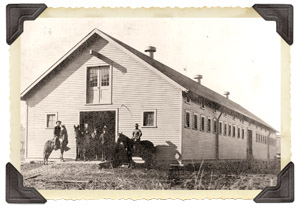Tour Stop L: History of Corrals and Stables
Even after the 1869 completion of the transcontinental railroad, the Army relied on mules and wagons to outfit its isolated posts. The Department of the Platte, headquartered at Fort Omaha, paid more than $700,000 to acquire and transport troops and freight.
Most of the freight, often purchased from Omaha businessmen, passed through the Omaha Quartermaster Depot. Supplies for the 1876 Little Big Horn campaign against the Sioux moved up the Missouri River from Omaha to Colonel George Armstrong Custer in North Dakota and by railroad from Omaha to General Crook in Wyoming. Millions of dollars in Indian annuities also passed through Fort Omaha.
 The need for larger military reservation away from the city closed Fort Omaha in 1896. Troops, livestock and equipment went to Fort Crook south of Bellevue, Neb. Fort Crook became the forerunner of Offutt Air Force Base where airplanes and mechanized vehicles replaced animal-drawn wagons.
The need for larger military reservation away from the city closed Fort Omaha in 1896. Troops, livestock and equipment went to Fort Crook south of Bellevue, Neb. Fort Crook became the forerunner of Offutt Air Force Base where airplanes and mechanized vehicles replaced animal-drawn wagons.
The section on Fort Omaha accommodated four large stables, corrals and a wagon repair yard at the peak of operations during 1876. Behind, a Chicago and Northwestern spur track linked the fort to the downtown Quartermaster Depot and to distant military installations.
Visit the Hospital…